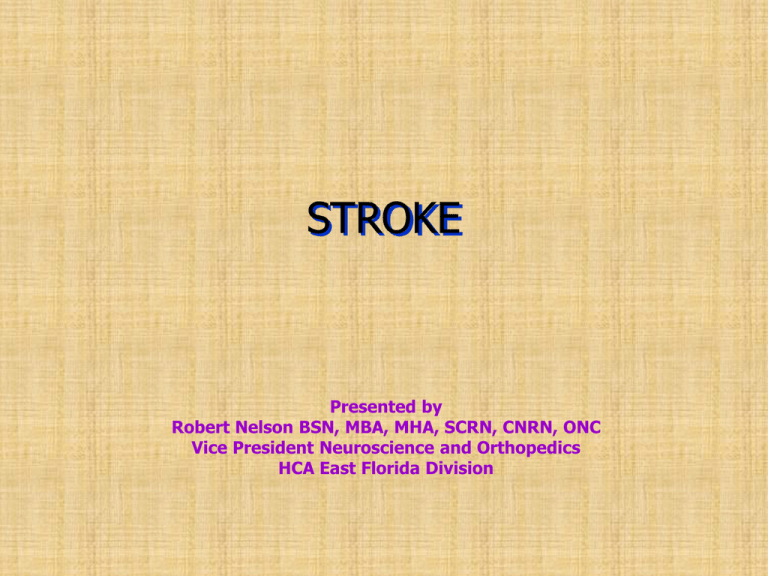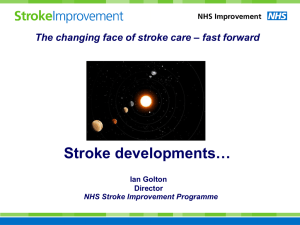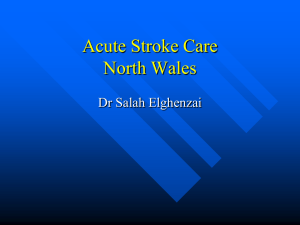PowerPoint Stroke PGH - Plantation General Hospital
advertisement

STROKE Presented by Robert Nelson BSN, MBA, MHA, SCRN, CNRN, ONC Vice President Neuroscience and Orthopedics HCA East Florida Division OBJECTIVES Discuss the Risk Factors for Ischemic Stroke Define two types of stroke ischemic and hemorrhagic Discuss the Evaluation and Work-up for Ischemic Stroke including Potential Thrombolytic Candidates Identify eligible stroke patients for thrombolytic therapy Identify the Primary steps in the management of Stroke Secondary prevention of stroke. Stroke Epidemiology and Risk Factors Stroke Stroke is an acute vascular event that affects the brain. Stroke involves neurological changes caused by an acute interruption of blood supply to a part of the brain. There are two main types of stroke. The first type is ischemic stroke, which results from decreased blood flow to a portion of the brain with consequent cell death. The second type is hemorrhagic stroke, which results from bleeding within the brain. Stroke Facts A leading cause of death in the United States 795,000 Americans suffer strokes each year 134,000 deaths each year - From 1996 to 2006, the stroke death rate fell 33.5% and number of deaths fell by 18.4% 6,400,000 stroke survivors Stroke Facts A leading cause of adult disability Up to 80% of all strokes are preventable through risk factor management On average, someone suffers a stroke every 40 seconds in America Non-modifiable Risk Factors Sacco RL, et al. Stroke. 1997;28:1507-1517. Age Gender Race/ethnicity Heredity Women & Stroke Stroke kills more than twice as many American women every year as breast cancer More women than men die from stroke and risk is higher for women due to higher life expectancy Women suffer greater disability after stroke then men Women ages 45 to 54 are experiencing a stroke surge, mainly due to increased risk factors and lack of prevention knowledge African Americans & Stroke Incidence is nearly double that of Caucasians African Americans suffer more extensive physical impairments Twice as likely to die from stroke than Caucasians High incidence of risk factors for stroke Hypertension Diabetes Obesity Smoking Sickle cell anemia Hispanics & Stroke Higher incidence among Mexican Americans than Caucasians Mexican Americans are at increased risk for all types of stroke and TIA at younger ages than Caucasians Spanish-speaking Hispanics are less likely to know stroke symptoms than Englishspeaking Hispanics, African Americans and Caucasians Stroke Risk Factors: Modifiable/Lifestyle Hypertension Excessive alcohol use Cigarette smoking Cocaine and IV drug use Hypercholesterolemia Physical inactivity Hyperlipidemia Oral contraceptive use Potentially Treatable or Modifiable Risk Factors for Stroke Heart disease (MI, CHF, PFO) Diabetes Menopause Obesity Atrial fibrillation Prior stroke or TIA Carotid artery disease Elevated homocysteine level Sickle cell anemia High RBC count Low socioeconomic status Management of Patients with Ischemic Stroke Stabilize the patient - A B C’s Restore or Improve Blood Flow Thrombolytic therapy Prevent recurrent embolism Maintain collateral flow Determine location and mechanism of stroke Prevent stroke complications Take steps for secondary prevention Evaluation of Stroke History and Physical Diagnostic tests Brain parenchyma Vascular system Brain Attack! Stroke is a “Brain Attack.” Stroke happens in the brain not the heart Stroke is an emergency. Call 911 for emergency treatment. 15 Definition of Stroke Sudden brain damage Lack of blood flow to the brain caused by a clot or rupture of a blood vessel Ischemic = Clot (makes up approximately 87% of all strokes) Embolic Hemorrhagic = Bleed - Bleeding around brain - Bleeding into brain Thrombotic Ischemic vs. Hemorrhagic CVA Ischemic Stroke Stepwise deterioration or progressive worsening Waxing and waning of findings Focal neurologic signs in the pattern of a single blood vessel American Heart Association. Heart Disease and Stroke Statistics—2003 Update. Hemorrhagic CVA Early and prolonged reduction of consciousness Prominent headache, nausea, and vomiting Retinal hemorrhages Nuchal rigidity Focal signs may not fit pattern of a single blood vessel TIA Transient ischemic attack (TIA) is a warning sign of a future stroke – up to 40% of TIA patients will have a future stroke Symptoms of TIAs are the same as stroke TIA symptoms can resolve within minutes or hours It is important to seek immediate medical attention if you suspect that you are having or have had a TIA Blood Tests rt-PA Candidates CBC, blood glucose, chemistry, PT, INR, and PTT HgbA1c Sickle cell disease Hypercoagulation work-up Sedimentation rate ANA Cardiac Enzymes Homocystein Fasting Lipid Profile Evaluation of Brain Parenchyma MRI CT Images courtesy of Regional Neurosciences Unit, Newcastle General Hospital, Newcastle, UK. Vascular Tests Noninvasive CT CTA R/O bleed R/O other conditions Identify early changes that would indicate poor rt-PA outcome To identify clots that could be treated with IA rt-PA MRI Confirms area of infarct with-in a few hours of the infarct Vascular Tests Non Invasive Carotid Dopplers More specific as to degree of carotid stenosis MRA Defines the degree of stenosis and areas of occlusion with the brain and neck Invasive Conventional cerebral angiography Risks (should be < 1% risk of stroke or death) Measurement of lesions Evaluation of the Vascular System Intracranial atherosclerosis Carotid plaque with arteriogenic emboli Aortic arch plaque Cardiogenic emboli Penetrating artery disease Flow-reducing carotid stenosis Atrial fibrillation Valve disease Left ventricular thrombi Reprinted with permission from Albers GW, et al. Chest. 2001;119:300S-320S. Heart Tests 12-Lead ECG Telemetry Echocardiography TTE TEE Aortic Arch Transesophageal echocardiography From: Siddiqui MA, Holmberg MJ, Khan IA. High-grade atherosclerosis of the aorta. Tex Heart Inst J 2002;29:60-2. Accessed at: texasheartinstitute.org/siddi291.html. Copyright © 2002 Texas Heart Institute. TREATMENT Thrombolytic therapy ACTIVASE, tPA, Alteplase Aspirin Blood pressure management Secondary prevention ASA, antiplatelets Anticoagulation Prevention of complications Rehabilitation Thrombolytic Therapy Time Is Brain: IV rt-PA approved in 1996 Must be given at a designated Stroke Center Must follow guidelines for administration Use of approved protocols, care maps, standard orders IA rt-PA under investigation Acute Stroke Treatments Ischemic stroke (Brain Clot) Clot busting medication: t-PA (Tissue Plasminogen Activator) Clot-removing devices: Merci Retriever, Penumbra Hemorrhagic Stroke (Brain Bleed) Clipping Coiling Current rt-PA Treatment Recommendations Reduce risk of ICH by closely following rt-PA protocol Time greater than 3 hours – greater than 6 hrs for IA rt-PA Poor blood pressure control Wrong dose Elevated blood sugar NIHSS Stroke Scale score > 20 rt-PA Inclusion/Exclusion Criteria Age 18 years or older Symptoms Onset IV rt-PA – 3 hours or less IA rt-PA – 6 hours or less consider for rt-PA Head CT – Rule Out Bleed Any concomitant diseases leading to bleeding? Recent MI, Stroke Recent trauma, major surgery Recent Bleeding Exclusion Criteria – rt-PA Medications that might increase bleeding? Exam findings – high risk of bleeding Anticoagulants Systolic BP > 185 Diastolic BP > 110 Lab findings – high risk of bleeding Prolonged INR, PTT Thrombocytopenia Exclusion Criteria – rt-PA Findings on neurological examination Very mild Stroke ( NIHSS score < 2-3 ) Very Severe Stroke (NIHSS score > 20) CT findings Hemorrhage Large Infarction Stroke Looks older than 3 hrs Current Usage rt-PA Under Usage of rt-PA at Stroke Centers: 1% to 3% Estimate is that 10% of eligible patients should receive rt-PA The most frequent reason rt-PA is not given is the patient presents outside the 3 hr. window Patient and Community Education Critical Blood Pressure in Ischemic Stroke Acute elevations of BP are common in stroke Often declines spontaneously in first 24 - 48 hours Seen in 85% of patients Cerebral autoregulation is defective in most patients Acutely lowering BP can expand area of ischemia BP Recommendations for Ischemic Stroke Patients Eligible for Thrombolysis Before rt-PA treatment Systolic > 185 or diastolic > 110 During and after rt-PA treatment Monitor BP per protocol Diastolic > 140 Nitroprusside Systolic > 230 or diastolic 121 - 140 Labetalol or nicardipine Systolic 180 - 230 or diastolic 105 - 120 Labetalol Labetalol Aim for 10%-15% reduction in BP BP Recommendations for Ischemic Stroke Patients Not Eligible for Thrombolysis Systolic < 220 or diastolic < 120 Systolic > 220 or diastolic 121 - 140 Labetalol 10-20 mg IV over 1 - 2 min (may repeat or double every 10 min) Nicardipine Diastolic >140 Observe unless other end-organ involvement Nitroprusside Aim for 10%-15% reduction in BP rt-PA Administer within 60 minutes of ED arrival and within 3 hour onset window Total IV dose 0.9 mg/Kg X _____(pt wt in Kg) = _____ mg Maximum total IV dose = 90 mg over 1 hour Bolus 10% total IV dose over 1 minute Then give 90% total IV dose over remaining 60 minutes TREATMENT /PREVENTION OF COMPLICATIONS Blood Sugar Control Positioning Depends on clinical situation 30% elevation helps to prevent aspiration Keeping the patient flat increases cerebral perfusion but time limited Bedrest with patients who are susceptible to orthostatic changes Prevention DVT prophylaxis Aspiration Early Mobilization Early Mobilization Depression Bowel and Bladder Protocol New Treatments Combined IV and IA Thrombolytics Clot Retrieval Devices Neuro-protective Agents Hypothermia Hyperbaric Oxygen Surgical Options Decompressive Craniectomy Used as a life saving measure for large hemispheric infarctions Brain is allowed to swell to decrease ICP and increase perfusion pressure Portions of the infarcted tissue are resected Mortality is decreased from 80% to 35% Outcome is improved Acute Therapy: Conclusions Acute stroke therapy requires a coordinated and focused approach IV rt-PA within 3 hours is a safe and effective if protocols are followed Workup should determine the cause and mechanism of the stroke Steps to prevent stroke complications can improve outcomes Stroke Recovery 10% of stroke survivors recover almost completely 25% recover with minor impairments 40% experience moderate to severe impairments requiring special care 10% require care within either a skilled-care or other long-term care facility 15% die shortly after the stroke Types of Stroke Rehabilitation Physical Therapy (PT) Walking, range of movement Occupational Therapy (OT) Taking care of one’s self Speech Language Therapy Communication skills, swallowing, cognition Recreational Therapy Cooking, gardening Types of Recovery Services Rehabilitation unit in the hospital In-patient rehabilitation facility Home-bound therapy Home with outpatient therapy Long-term care facility Community-based programs Secondary Prevention of Stroke and Other Vascular Events Secondary Prevention Educate the public One or two education sessions per month Health fairs BP screening Cholesterol/triglyceride levels Serum glucose levels Presence of A-fib Lifestyle evaluation Blood Pressure Control Is Inadequate in the US Millions of People 23 13 13.5 Unaware Untreated Inadequately treated 140/90 mm Hg Arch Intern Med. 1997;157:2413-2446. JNC-IV. Trilling JS, Froom J. Arch Fam Med. 2000;9:794-801. 16 Secondary Prevention of Stroke: Percentage Prevented per Year % of strokes prevented/yr 0 Antihypertensives Clopidogrel vs. ASA Warfarin Statins Smoking Cessation Aspirin Carotid Endarterectomy Straus SE, et al. JAMA. 2002;288:1388-1395. 2 4 6 8 10 12 14 16 18 Modifiable Risk Factors and Preventable Strokes Risk Factor Projected strokes prevented* Hypertension 360,000 Smoking 90,000 Atrial Fibrillation 69,000 Heavy Alcohol Consumption 34,000 *Based on 731,000 strokes. Adapted with permission from Gorelick PB. Stroke. 1994;25:220-224. Biblography/ References AANN Clinical Practice Guideline Series; Guide to the Care of the Hospitalized Patient with Ischemic Stroke 2nd edition National Stroke Association; National stroke association.org Guideline for Healthcare Professionals From the American Heart Association/American :Guidelines for the Early Management of Patients With Acute Ischemic Stroke: American Heart/Stroke Association






